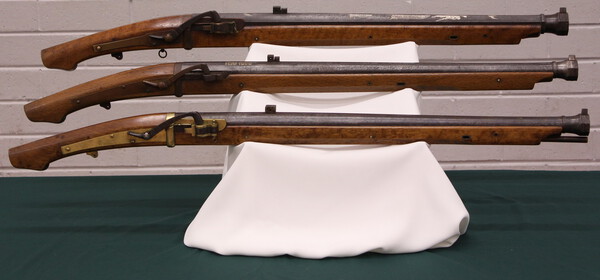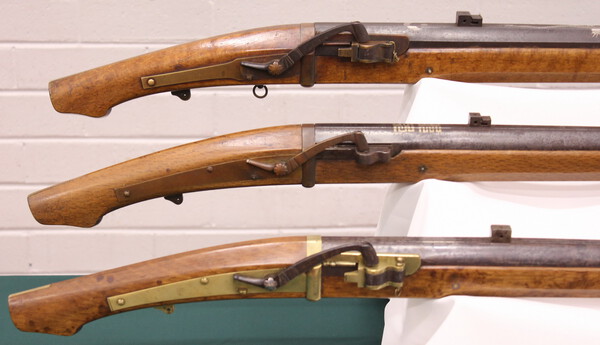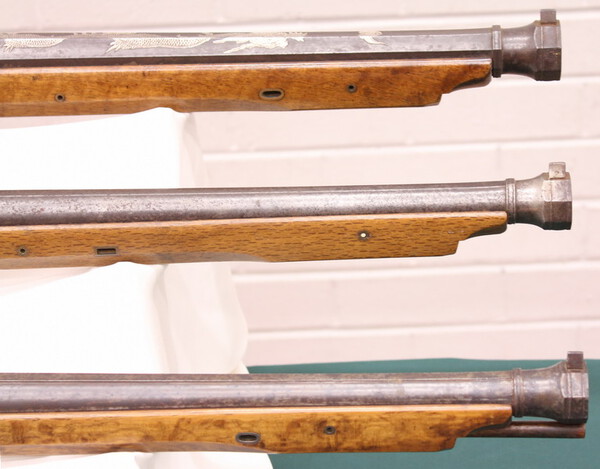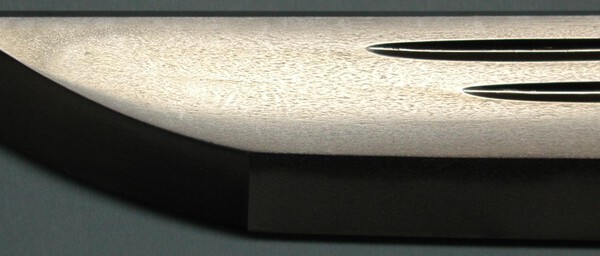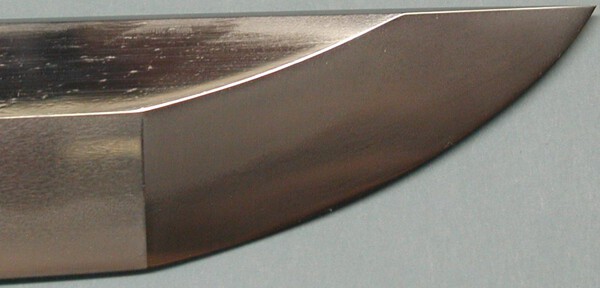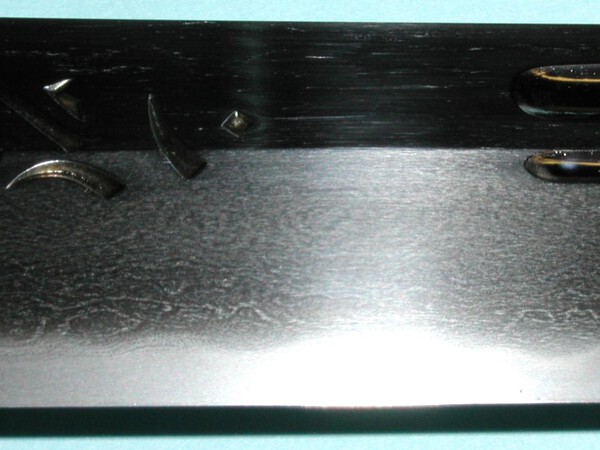-
Posts
2,756 -
Joined
-
Last visited
-
Days Won
27
Content Type
Profiles
Forums
Events
Store
Downloads
Gallery
Everything posted by Bazza
-
Hmmm - should "kiriha zukuri side" be "hira zukuri side" and "shinogi zukuri side" be "kata shinogi side"????? BaZZa (OTTOHH)
-

Disappearance of post post numbers
Bazza replied to Ken-Hawaii's topic in Forum Technical Details and Maintenance
I have found the Post # to be very valuable in PM replies especially, also in Forwards addressing specific points in a topic. I'm pretty sure it was extant in the previous software right up to "the end". BaZZa. -
On another board I kept reading things like "the mum has gone...". It took a little while to realise "mum" was shorthand for chrysanthemum... "Mum" is also the Australian equivalent of the USA "Mom". BaZZa.
-
This very thing happened with a sword in a Shinsa. The sword was pinked even though the owner had identical signatures in his reference books and he challenged the result, to no avail. Hence the old saying "submit to three different shinsa before making any decision" ( in this situation about removing mei). Of course, three Shinsa is costly and the sword (or fitting) would have to be well worth it. BaZZa.
-
Well, I have a Shingunto with a circa 1650 katana by the Hizen Nidai Tadahiro. The blade has been polished in Japan and gained Tokubetsu Hozon and resides in a gorgeous Tora Honoki shirasaya with a gold foiled silver habaki. The koshirae has a tsunagi with the original habaki and resides in a splendid bag that I bought off a Board member. When I curl up my toes the blade and koshirae will go to its new custodian together, along with the letter from the Japanese Colonel who owned it to the Australian major who took it in surrender. It might not be widely known that the Shingunto koshirae is modelled on a circa 1400 tachi koshirae and therefore represents the most recent "fit out" for war. Given that any katana with considerable age has no doubt had many koshirae refits in its lifetime - including "fashion" changes eg., the New Year koshirae - it is absolutely pointless and a historical heresy to take a blade out of its Shingunto koshirae and put it in an ersatz mockup, for that's what it is even with antique fittings. A case in point. I was at a gun show 2,000 miles from my home town going through a dealer's stock of swords when I picked up a sword in "civilian" (i.e., dealer's homemade) koshirae. It just didn't look right - they never do, Adam - but imagine my surprise when I pulled the blade and recognised it instantly. It had belonged to a friend of mine who had passed it off in a trade some considerable time before. When I first saw it the blade was in a very respectable Shingunto koshirae with an interesting blanco handle. All very nice and eminently collectable. I can imagine the koshirae was broken up into component parts and sold off as "spares" to maximise return on the Holy Dollar. The salient point is that the "homemade" (dealer) koshirae did absolutely nothing for the sword, nothing at all. So I am most certainly with John and Chris. Make a koshirae for it if you have to Adam, but to someone who has sensibilities it will be instantly recognisable for what it is, an insufficient copy. At the same time, make a tsunagi for the Shingunto koshirae and keep it with the sword for the next custodian who might break up your creation and reunite the blade with its Shingunto koshirae. Unless, of course, you have the blade professionally polished and that of course is another kettle of fish!!! BaZZa.
-
Josh, Welcome to the Board and the wide, wonderful World of the Japanese sword. Its a bruising experience to be told that something you have is not the real deal, but I do hope you will stay around and explore the Board to see the possibilities in this enthralling study of Nihontou. I take my hat of the Steve M who is a stalwart on the Board for difficult translations and his recognition of the smith and period. If the blade is a non-genuine Nihontou it means a Chinese (?) source has done a good job of copying the signature of an obscure smith in a reasonably competent way, but the offset machi (notches) is pretty much a giveaway indication of a Chinese copy. I think it would help if you could clean the baby powder off the tang and photograph both sides including the notches looking straight down on it. We can then see more clearly the colour of the tang and style and condition of the filemarks. It also greatly helps if you orient the photos vertically. Best regards, BaZZa. (Melbourne, Australia) EDIT: I do want to edit this for everyone's benefit, I hope. I had JUST completed the reply above when my computer suddenly went down. A household fuse had blown and I thought "There goes my reply". So I came back on wondering where a draft might be kept... I was still connected to the Board and when I pressed "Reply..." my draft was all there. Wundebar etc etc. So here it is...
-
I couldn't login 5 times then got a message, so I knew the site was live. I changed my password and straight in though a profile request, so it seemed to treat me like a new user. Of course, none of this is helpful for the folk who still can't get in. BaZZa.
-
Nice find Peter, BUT - if one lets the video roll on there are at least another three very interesting videos as far as I watched. I'll go back and spend more time there, hower I did find this one of great interest indeed: BaZZa.
-

KEITH MUELLER, PHOENIX, ARIZONA - looking for
Bazza posted a topic in Tanegashima / Teppo / Hinawajū
Many years ago in my Nihonto collecting daze I thought Japanese guns were by and large crappers. This opinion came from the only guns I had seen over the years, and at that very, very few. Then Keith Mueller wrote a series of articles in the Nanka To-ken Kai newsletter put out by (I think at the time) John Grimmitt (sp??). Keith's guns and writing completely changed my mind about teppo. As good fortune sometimes has it, the first really good teppo by Tayosuke Katsumasa came into my life a couple months later and I was ready for it. Traded a set of nice menuki, a presentation Gendaito, and a lump of cash to get it. I have never regretted the deal and over the ensuing years have added four more teppo of equal stature to the first. My question is - does anyone know where Keith Mueller is "at" these days and what might have happened to his collection??? I would really like to contact Keith again so his wonderful essays on his collection, which changed my view of teppo, could be put up in this topic with his permission. BaZZa. -
I meant to add that I have two more teppo that I have been "gunner" put up for some time, a big Oh-zutsu and a little bajou zutsu. I should also measure the above 3 guns and put their details up as well, but I do battle with straws on my back!!! I also have oshigata of a HUGE teppo with sanju makibari inscription that I was able to borrow for a short time many years ago. Sadly I couldn't afford the asking price at the time and it has "disappeared" into the wilds of suburbia. Maybe it will pop up again somewhere, sometime. Thank you Piers for the detail about Katsumasa that I must add to my records. Bestests, BaZZa "Gunnadoo" Thomas.
- 18 replies
-
- 1
-

-
- tanegashima
- teppo
-
(and 3 more)
Tagged with:
-
Congratulations indeed XXX. A hurried note before lunch and more chopping wood after... I have two teppo signed by Tayosuke Katsumasa. These are shorter guns with internal springs and I just love their lines. Here is a few photos I put aeons ago. The two on the bottom are by Katsumasa. BaZZa.
- 18 replies
-
- 2
-

-
- tanegashima
- teppo
-
(and 3 more)
Tagged with:
-
I agree with John that it is the original hamon. John I think you are thinking of yahazu, arrow notch hamon, but to me it looks more mimigata (ear-shape). In this photo it is possible to just see a narrow ashi the length of the tani, the valley between the peaks (between the 3rd and 4th "ear"). It sort of speaks of a quality, well-quenched sword, but having said that overall I would guess it is a lower class blade that needs to be seen by an experienced eye or ten to really see what it is. BaZZa.
-
Well, while we are on the subject here is my contribution. I've orientated the photos in the way I think makes most "sense"! BaZZa.
-
"After jumping pull ripcord" ??? Gibberish??? Looks like a well-intentioned effort to copy kanji by an Allied serviceman... BaZZa.
-
Hmmm, I'll go and look at my old Sengo blade in Shingunto koshirae, with unusual hanger. I've been meaning to put it up here for a long time - straws on my back!!! BaZZa.
-
A real teaser Jacques, and a VERY good lesson in the universality of some sword features. JP said it - "Muramasa looked so obvious I dismissed it immediately!" I can only think that those of our number who did not have a guess all knew The Answer. My real gut feeling is that they didn't have a clue!! C'mon now, who amongst our cognoscenti REALLY knew The Answer??? Be upfront about it, for this is surely what NMB is about amongst our everyday (enjoyable nonetheless) banter. This was fun, Jacques, and a few more in your busy day wouldn't go astray!!! BaZZa. ,
-
As JP says, this is almost certainly a "trap" sword!!! I would definitely say not Koto. With a suguyakidashi, sampin boshi and that slight taper from the monouchi to the kissaki I would have to say Shinto era. The hamon certainly reminds me of a sword I've seen and it does have Mino traits in the sanbonsugi style. Other than that, I would say it is an excellent sword whenever it was made!!! Possibly an utsushi. Looking forward. BaZZa.
-
Ahh, c’mon guys, go easy. Guido is one of THE most knowledgeable people on this Board and we should be grateful he shares his time with us - I know I am. Guido wrote: > As for not having a yokote: I’ve never seen a hirazukuri/katakiriba combination blade > in my 40 years of collecting that had a yokote; probably because there is no such thing. Anyone who wants to cast a shadow over Guido better have (a) the best of intentions, and (b) sound research techniques!! My response to Guido’s comment quoted above is merely that I have a shinogizukuri/katakiriba combination katana that has a yokote on the kiriha side. This is not to naysay Guido, as mine is shinogizukuri and not hirazukuri, which is certainly not the same thing and I mention this here in case we can draw another insight from this thread. Guido has commented on my sword in another thread: http://www.militaria.co.za/nmb/topic/3100-katakiri-ba-blades/?hl=kiriha&do=findComment&comment=30332 and I’m shocked to see that was in 2008... I apologise for the poor quality of the images, taken many years ago. Reminds me that I should update them. BTW, we don't see much comment from Guido, but when we do it is always a valuable learning lesson and I always look forward to it. In fact, I know Guido is lurking in the background and I always, ALWAYS, hold my breath when I write something in case it is a heresy or shows poor reading of the sacred texts!! I go now to my wife's excellent dinner and my hand-me-down bottle of Tasmanian pinot noir (from my local mechanic for my beer contribution to his workshop). This is just the fag-end of the bottle as I gave it a hammering at last night's dinner. BaZZa.
-
Many decades ago I was shown in an art gallery storeroom a beautiful yari mounted in a stunning olive-green lacquered koshirae with a high relief gold lacquered dragon winding around the koshirae. I've never forgotten it. BaZZa. EDIT: I also once had a small yari signed SHOAMI in a tanto-style koshirae. The tang had been cut and the yari turned into short self-defence weapon.
-
In this image the hamon almost looks like JUZUBA – Buddhist beads – a form of gonome hamon. (From http://www.samuraisword.com/glossary/) BaZZa.
-
Gents, lovely koshirae, very desirable IMHO. Now the rust. Long ago - decades in fact - the late lamented Alan Harvie while visiting Australia commented on an attempt of mine to remove rust from an iron tsuba. I had carefully picked away at the encrustation of rust with a de-tempered scalpel blade to remove as much as I could. This left pits where the rust had more severely bitten into the iron surface. Alan remonstrated with me saying that it would have been better to use the small flat of a bone (or ivory) with oil and gently abrade the surface until the rust was level with the original iron surface. This technique would therefore have left a smooth surface rather than a pitted one. Hopefully!! So, Robert, I would go with using an expert, of which there must be a few in Japan. And I would guess to do this restoration work at a professional level might cost as much as the koshirae??!! BaZZa.
-
It looks like a TERRIBLY abused Nihonto. The nakago has been thoroughly cleaned to the point of uselessness to assist determining age. I would think only a properly trained polisher could give an opinion by putting in a window and sadly I think that would cost more than this poor specimen is worth... Worst case of abuse I have seen in a very long time. BaZZa.
-

Japanese Swords & Furniture Museum of Fine Arts Boston
Bazza replied to Babu's topic in Wanted to Buy
Ah, GAAD, how could I forget that??!! My handling fee in one instance cost me AUD $500... (slaps forehead)


